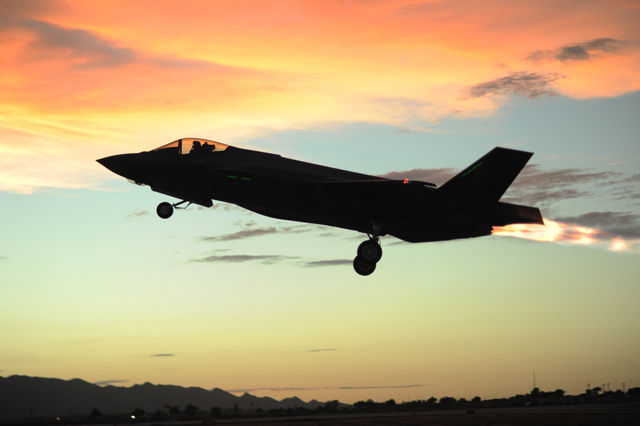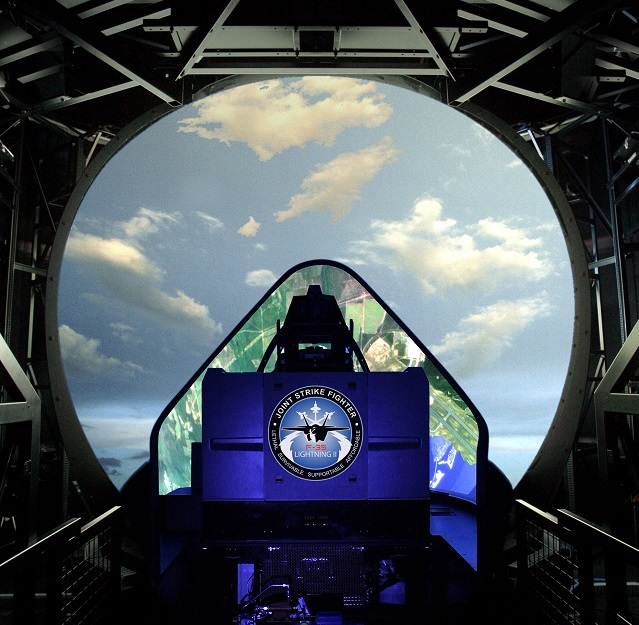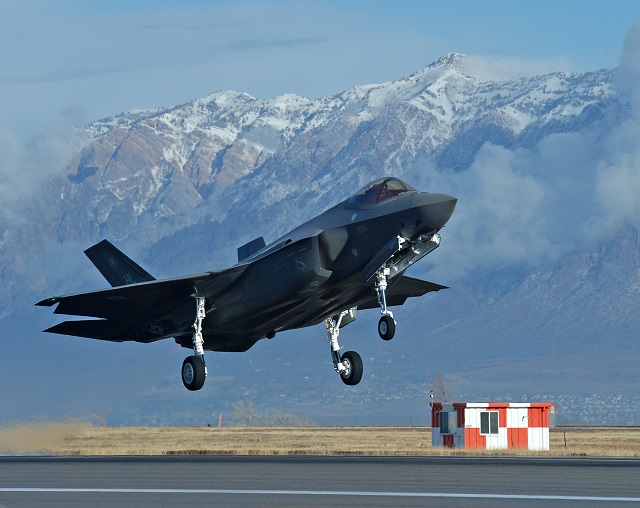The Lockheed Martin F-35 Lightning II is not just one of the most expensive and complex endeavours in military acquisition history, it’s also an evolution in the way military pilots train to fly jets.
Developed during the computer networking revolution of the 2000s, everything from the way the aircraft is maintained to the way it fights is deeply interconnected, as are its “full-mission” simulators.
When a squad of F-35s fly into combat for the first time, the pilots will have already performed that exact mission against those target objectives dozens, if not hundreds, of times in simulators, replicating everything from electronic jamming to weapon effects on surface-to-air missile sites.
Not only does the F-35’s full-mission simulator provide greater fidelity than previous generations of fighter trainers, it also compensates for the fact it is too expensive to equip every test and training range with the full complement of threats it would be likely to go up against. The only places an F-35 can truly wreak havoc with every kinetic and non-kinetic tool in its beyond-visual-range arsenal, will be in the virtual simulator or in combat.
It’s not just belt-tightening that has Lightning II pilots completing 45% to 55% of their initial qualification flights in the simulator – it’s the next-generation fidelity and risk-free exposure to the full range of things that can go wrong or harm you, particularly on the electromagnetic spectrum.
Each simulator carries the most recent software load, or operational flight programme (OFP), so it can most accurately replicate the capabilities and handling qualities of the aircraft as it is concurrently developed, tested and fielded through various block upgrades.
The simulators arrive in groups of two or four, and will all eventually be plugged into the vast network of American and allied training simulators at air bases and training centres around the world, bringing F-35s into the same virtual environment as F-16s, F-15s, Boeing C-17s and others.
According to one air force official, the “Holy Grail” of simulator training will come with the introduction of live, virtual and constructive (LVC) networking between training devices and aircraft, with blue forces going against aggressors at every level for full-spectrum combat training.

Lockheed Martin
GLOBAL EXPANSION
A dozen nations are seeking upwards of 3,000 F-35s up to 2030, and Lockheed is scaling up significantly over the next five years to accommodate that demand. Though the top priority this year remains the US Air Force’s initial operational capability declaration for the conventional takeoff and landing (CTOL) F-35A variant in August; the UK, Israel, Norway, Turkey, Australia and Italy are also preparing to establish their first combat-ready squadrons.
This global F-35 expansion is the ultimate test for Lockheed in terms of manufacturing, logistics and in-service support. But equally important is the rollout of the multinational training programme – a monumental task in itself.
The company is already contracted for 209 F-35s through the eighth low-rate initial production lot, and is nearing an agreement for 157 more aircraft in Lots 9 and 10. The company has also secured a long-lead materials contract for 91 aircraft expected in Lot 11. Propulsion system supplier Pratt & Whitney is also increasing production with a handshake agreement for 167 more F135 turbofan engines.
Meanwhile, Lockheed’s mission systems and training division has contracts for 87 full-mission simulators plus two options, out of 239 that will be required under the current programme plan. It also has orders for 31 maintenance trainers.
Lockheed will install full-mission simulators at every major F-35 operating location domestically and abroad, and seven sites have already been established across the USA.
The US Department of Defense (DOD) now has integrated training centres at Eglin AFB in Florida, Luke AFB in Arizona and Marine Corps Air Station (MCAS) Beaufort in South Carolina, and is standing up a fourth exclusively for the F-35C carrier variant at Naval Air Station (NAS) Lemoore in California. Simulators have been delivered to Nellis AFB in Nevada and the first combat-coded F-35 locations, at MCAS Yuma in Arizona (F-35B) and Hill AFB in Utah (F-35A).
Training centres are being established for each international F-35 operator, depending on their individual requirements. Six international F-35 operators already have pilots and 'maintainers' training in America, including foreign military sales customers Japan and Israel.
Lockheed F-35 training system director Mike Luntz, tells Flightglobal full-mission simulator production is ramping up to two units per month in Orlando, Florida. Much like the airframe and engine, a global supply base feeds the line, with industrial input from nations committed to purchasing the jet.
As of 19 January, 24 simulators have been delivered to seven locations, with 63 more on contract through the ninth low-rate initial production lot. For Lightning II maintainer training, the company has delivered 13 aircraft systems maintenance and part-task trainers, with 18 more on order.
“We’ve got a pretty well-refined production process we’ve ramped up here in Orlando,” says Luntz. “That backlog is to align with customer requirements and delivery dates in their base or country.”

There are no two-seat F-35s, so quality simulator training is a crucial precursor to live flying
US Air Force
It takes about a year to establish a training centre. For instance, Lockheed will begin installing simulators at Israel’s Nevatim Air Base in 2017 ahead of F-35I IOC later that year. In 2018, pilot and maintenance training systems will be installed in Japan, Norway, the UK and Australia.
“We’ll be installing the equipment in 2018, to start training activities in 2019,” says Luntz.
To date, there are 251 qualified F-35 pilots including 15 internationals. On the maintainer side, 2,445 personnel have been qualified to sustain and repair the aircraft, including 2,217 from the US military services and 228 from international forces. As an original programme partner, the UK has made the most headway, with four pilots and 135 maintainers trained and ready.
FULL-MISSION SIMULATION
When a qualifying pilot steps into an F-35 for the first time, it won’t be with an instructor. One will follow behind in a chase airplane – probably another F-35.
Unlike the Lockheed F-16 and Boeing F/A-18, there is no twin-seat version of the F-35, so operators must rely on quality training in the simulator. It would certainly be daunting to take control of a high-thrust F-35 for the first time, especially knowing your government just paid upwards of $100 million to obtain it.
There’s nothing new about a one-seat combat jet, but the extent to which the F-35 programme relies on its simulators for flight and mission qualification is new, even compared to the F-22 Raptor.
“There is more training being done in the simulators than any other legacy aircraft,” says Luntz. “More than 50% of the initial qualification flights actually take place in the simulator.”
Former F-16 pilot and commander of the 56th Fighter Wing at Luke AFB, Brig Gen Scott Pleus, says there’s “nothing lost” by shifting from legacy “full-motion” simulators to the new “full-mission” simulator, except the jacks and hydraulic actuators. It allows for improved 360° visual displays that incorporate the helmet-mounted display and cueing system and distributed aperture cameras that give the F-35 unparalleled spherical situational awareness.
“It’s by far the most accurate fighter simulator I’ve seen in my career,” says Pleus. “We will rely even more heavily on simulator usage on F-35 because of the level of classification the simulators can give. We won’t have a lot of capability to do that in live-fly training.
“The sims can do almost everything we can do in the air, except feel the movement of the actual aircraft,” adds Lt Col George Watkins, commander of the 34th Fighter Squadron – the air force’s first combat-coded F-35 unit. “From what you see to what buttons you push; you can do everything you do in the air in the simulator. You can actually do more things in the simulator, because we can give ourselves more adversaries, we can give ourselves more threats on the ground to simulate potential adversary countries, and what kinds of things they can shoot at us – as well as tanking, night flying and flying in a larger force package.”
Once fully developed, the aircraft will become a frontline hunter, designed to destroy complex, overlapping surface-to-air missile systems, while also guarding against interceptors.
It’s not as highly manoeuvrable as an F-16, but it compensates via long-range sensors, weapons and a sophisticated electronic warfare suite – all optimised for beyond-visual-range engagements.
In day-to-day operations, an F-35 must provide air cover to ground troops in contact, or carry out precision bomb raids on pre-planned targets – all the while networking and sharing information with space and cyber assets as well as other coalition aircraft in the vicinity.
Watkins says these missions can be practiced over and over in the simulator, and then again at live test and training ranges or at large-scale exercises like Red Flag.
Suppression or destruction of enemy air defence missions are especially complex, and it’s overly expensive to replicate those scenarios in live training environments, he says – particularly electronic warfare.
“That’s an advantage F-35 simulators have over legacy,” says Watkins. “I know in the F-16 world, we were not able to simulate any type of jamming in the simulators, but that’s one of the baseline-standard capabilities that the F-35 brings with it.”

F-35 full-mission simulators receive the latest aircraft operational flight programme software
Lockheed Martin
FOUR-SHIP TACTICS
When the F-35 goes to war, it won’t go alone. As explained by USAF vice chief of staff Gen David Goldfein in a recent televised interview: “Unlike the F-117 where I would close off the world, the F-35 opens up into the network. It’s a networked approach to how we do [the] warfare of the future.”
This joint approach to warfare is replicated in the simulators, starting with basic “four-ship” F-35 training at the unit level, and scaling up as those simulators connected to live and virtual training networks.
According to Col David Lyons, commander of the 388th Fighter Wing, Hill AFB’s four simulators were plugged together in December, and now four local pilots can fly together in a single virtual training environment. Today, that environment replicates the local area and Nellis AFB, but it will eventually be loaded with potential areas of operation, populated with the latest Russian and Chinese fighter jets as well and new types of anti-aircraft weapons and jammers.
“We don’t necessarily have that full complement of threats, or the degree of those threats, on our range,” Lyons says. “[In the simulator] we have the ability to link everybody together with multiple aircraft and different airplanes of the future, and shape the scenario into a high-end threat [situation] that will challenge even the best of our pilots to be successful. We can’t yet achieve that in our range airspace.”
Lyons say the eventual introduction of live, virtual and constructive networking will be transformative in the way pilots train to fight, and US companies are already coming up with ways to do that.
“We’ll use our live airplanes on the range and have folks in the simulator contributing to a scenario that is also being flown live,” he explains. “We’re not there yet, but that’s our ultimate goal.”

The US Air Force will declare IOC with the F-35A at Hill AFB in August
US Air Force
NEW STUDENTS
Until now, every pilot operating an F-35 has transitioned across from another combat aircraft community – most having flown the F-16, Fairchild Republic A-10, or McDonnell Douglas AV-8B or F/A-18. This year, the air force and Marine Corps will receive their first newly qualified aviators, who have only limited experience flying combat jets. No doubt, they’ll be best and brightest of their classes, but their fast-jet flying experience will be limited.
Cap Clay Groover, a spokesman for the F-35 programme at MCAS Beaufort, says the marine’s first “Category 1” pilot reported for training duty in December. That student’s introduction will help evolve the local training syllabus and open up new avenues for young and ambitious aviators wanting to fly the F-35.
“He just graduated from NAS Kingsville not too long ago,” says Groover. “We’ll still get some transitioning pilots, but as the pilot training programme keeps evolving and progressing, we’re going to get more Category 1 pilots out here.”
The newly-minted flight officer will receive basic classroom academics and computer-based flight training before strapping into the full-mission simulator and aircraft.
“The best of the best get to come out here and train on the F-35,” says Groover. “We’ve also trained over 500 maintainers, who are important to keep the thing in the air.”
The captain says training at MCAS Beaufort will ramp up by 25% over the next four years, and the local marine fighter-attack training squadron (VMFAT-501) hopes to have 60 pilots graduate in 2016. This includes a handful of British pilots, since the UK is the largest foreign F-35B customer, with plans to purchase 138 of the short take-off and vertical landing (STOVL) variants for the Royal Navy and Royal Air Force.
Luke AFB will receive its first new graduate, or “basic course” student, this summer following his or her introduction to a fighter fundamentals course. That student will have logged 200h of flight time in the North American T-6 and Northrop T-38 and AT-38 before taking control of an F-35A, making preparations in the full-mission simulator that much more critical.

The US Marine Corps achieved war-ready status with the F-35B in 2015 and will deploy to Japan in mid-2017
US Marine Corps
New Syllabus
The F-35 programme is about six years behind its original rollout schedule and well over budget, but as issues identified in developmental testing are slowly resolved and flight restrictions removed, F-35 training centres can expand their training syllabus to include new weapons, tactics and flight profiles.
In April, Luke AFB will begin focusing more on combat manoeuvres and weapons employment, instead of just general flight qualifications.
The wing commander says the new syllabus will include basic fighter and air combat manoeuvres, such as air-to-air engagements and tactical intercepts. Eventually, as its F-35A fleet is upgraded to the latest design standard, the training squadrons will begin releasing weapons at the range.
“When the combat pilots transition to the air-to-air phase and air-to-ground phase, they’ll start with basic surface attack and then move into actual weapons employment,” says Pleus. “Eventually we’ll work into large-force exercises where they’re doing offensive-counter and offensive-surface attack tactics and defensive surface attack.
“It’s comparable to how we train our air-to-ground fighter jets, the F-15E and F-16, but the difference between the fourth-generation and fifth-generation is the weapons systems that the F-35 brings, as well as the low-observable capabilities of the airplane.”
Hill AFB has received the newest F-35As off the production line, all in the weapons-grade Block 3i standard. Lyons says weapons training should begin at the Utah Test and Training Range in February or March, and pilots will begin flying four-ship combat tactics at around the same time.
Those pilots frequently simulate weapons releases in their training flights, but doing it live counts more.
“It is a monumental achievement, because we are the first operational unit to do it. But quite frankly, I don’t expect it to be a difficult achievement for us to accomplish,” Lyons says. “The airplanes are ready and the pilots are ready.”

Flightglobal/USAF/Lockheed Martin
Source: FlightGlobal.com























